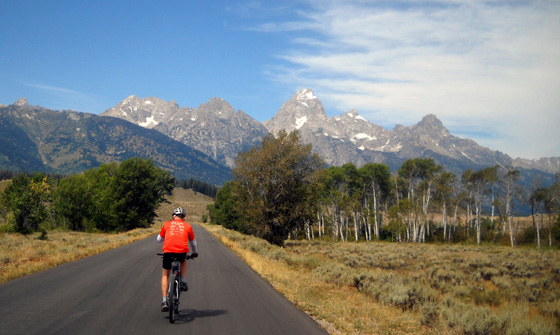(Continued from the last page.)When to visit Alaska is a very personal decision but it is often dictated
by the weather -- and whether you can get
reservations when and where you want them. Other obvious factors are
your job and if you have school-age kids.
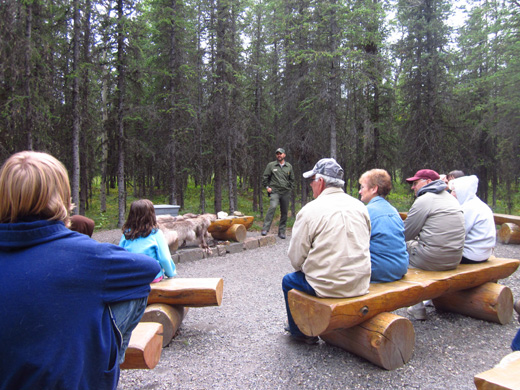
Kids from 8 to 88 enjoy the ranger
talks at the campgrounds in Denali NP. (8-6-12)
If you're retired or have most of the summer off (like teachers), you
have a lot more flexibility.
Even so, you need to consider when the most people are traveling to
and around Alaska, the weather, road conditions, and other factors.
PEAK VS. SHOULDER SEASONS
Let's start with crowds because that can affect your ability to make
reservations if you want to make them.
I've read different dates for the peak tourist season in Alaska and the
less-busy times called the "shoulder seasons" at either end.
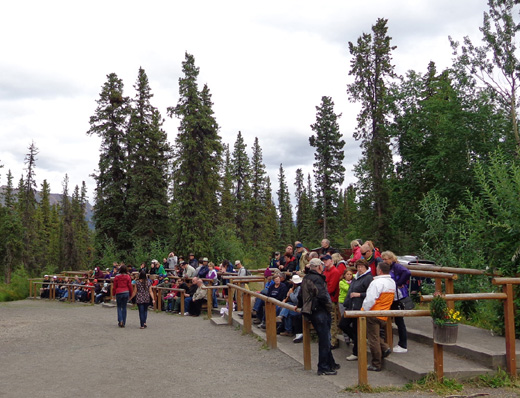
A good-sized crowd waits for the
sled dog demonstration to begin at Denali NP.
About double that amount were
present by the time the presentation began. (8-7-12)
In general, the peak is from mid-June to mid-August when the
temperatures are warmest, hours of daylight the longest (about 22
hours/day in Fairbanks on summer solstice), and kids aren't in school.
During this time you can expect to pay the highest prices, popular
attractions will be the most crowded, and reservations will be the most
difficult to make (every kind of land, water, and air tour, plane,
train, ferry, and cruise fares, accommodations, campgrounds, fishing
charters, etc.).
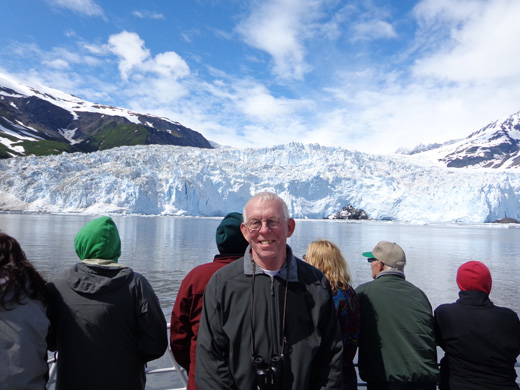
The deck of our catamaran was always full of people
when the captain stopped or slowed
down to look at glaciers, sea birds, whales, etc.
Jim's smiling at me in front of Aialik Glacier
in Kenai Fjords National Park during our fabulous
day cruise from Seward, AK. (7-9-12)
Costs are generally lower, reservations are easier to make, and tourist
attractions are less crowded before and after that, particularly in
May/early June and September/October. However, some places aren't open
then and it's not as warm. There are still plenty of daylight hours
during those periods of time, although daylight quickly starts to wane
in late August/early September (by about an hour a week).
It was interesting to see who was where when as we wandered
around Alaska during the summer.
For example, we could see a noticeable
difference in who was camping at Denali National Park on our first visit
there in early August (many families with school-age kids) and on our
second visit in late August/early September (no school-age or college kids
but lots of foreigners who took advantage of low off-season air fares).
TIMING & WEATHER PATTERNS
The peak tourist season in Alaska varies to some extent by latitude and elevation,
just as it does in other parts of the world. That's mostly due to the weather.
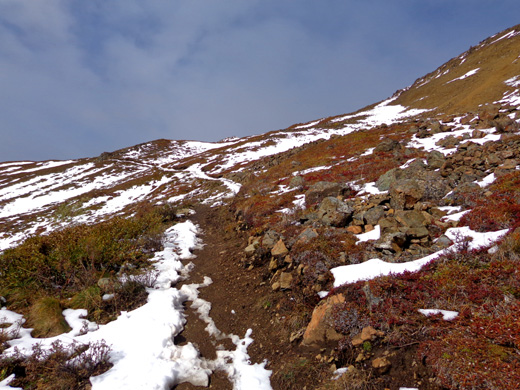
Bright fall colors and early
snow that fell as low as 3,000 feet elevation made this alpine
hike above the Eielson Visitor
Center at Denali NP more interesting. (8-29-12)
Denali National Park is a good example of this, too. The park has a really short summer season
because most of its territory lies at higher altitudes. Autumn is even
shorter.
There were fewer shuttle
buses and ranger talks on the schedule when we visited the park around
Labor Day than when we were there in early August.
By about the third week in September -- or whenever snow makes the road impassable
-- the park is closed to visitors' vehicles three miles past the
entrance. Access to the other 89 miles is by dog sled and cross-country skis.
Snow was already falling down to the 3,000-foot level in Denali when
we were there in late August:
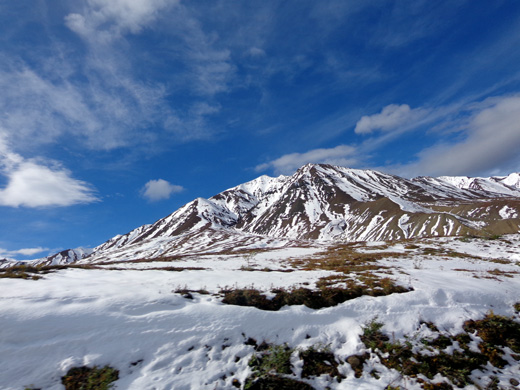
Even though it was still summer
on the calendar, we got to see the first
snowfall at Denali NP along the interior park road on August 28-29.
Only a few days after Labor Day, when we were 125 miles up the road
in Fairbanks, we heard that enough snow fell near the Eielson Visitor
Center to shut down the shuttle bus system for a day. The same thing
happened a second time the same week.
Sounds like winter's coming even earlier than usual at Denali!
In general the Southeastern region (Juneau, Ketchikan, etc.) and
South Central region of Alaska (Anchorage, Valdez, Seward, Homer,
Kenai, Soldotna) are cooler and wetter in the summer than the
Mat-Su Valley (Palmer, Wasilla, Talkeetna) and the Interior (Healy, Fairbanks, Delta Junction,
Tok).
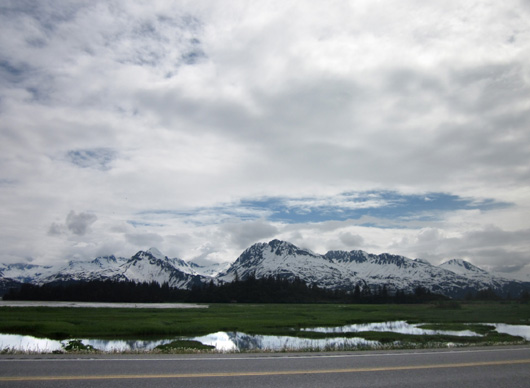
The sky was cloudy the four days
we were in Valdez but it didn't rain much. (6-15-12)
I've read that July, 2012 was the chilliest July on record in
Anchorage and some of the other towns in the South Central and Southeast
parts of the state. We spent most of our time this summer in South
Central Alaska and the Mat-Su Valley, which is sandwiched between
Anchorage and the Interior.
I can count on one hand the number of days we had temperatures of 70
F. or higher.
Even though it is farther north, Fairbanks tends to have a longer,
more comfortable tourist season with drier, warmer summer weather. I
often checked the forecast for Fairbanks while we were in Alaska. Many
days were in the 70s and 80s F. there while we were lucky if we saw 65 F.
in Anchorage.
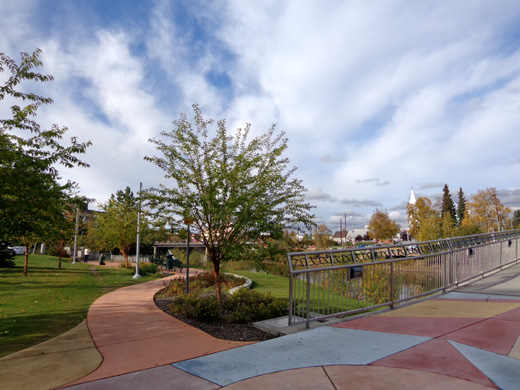
Despite some clouds, Fairbanks
was warm and dry while we were there in September.
This is part of the popular
Riverwalk along the Chena River in the downtown area. (9-4-12)
The Interior just isn't affected as much by the cold, wet
weather systems that develop over the ocean and gulf along the more
coastal areas. That said, we found a lot more to do in Anchorage, Valdez, the Mat-Su
Valley, and the Kenai Peninsula than we did in Fairbanks, where we spent
just a few days.
No matter where you go in Alaska in the summer, however, take warm
clothes, a water-resistant jacket, and an umbrella! The weather is
very unpredictable.
TIMING & ROAD CONDITIONS
Road conditions and services in Alaska and northern Canada are best from mid-May to mid-October but we
discovered that even in early September some sections of pavement were
still in need of repair and some businesses and visitor centers had
already closed for the season along the northern two-thirds of the Alaska Highway.
The same thing happens at the beginning of the spring/summer travel
season. Some services aren't available until June. (A lot of those
business owners are either snowbirds or have other jobs during the winter.)
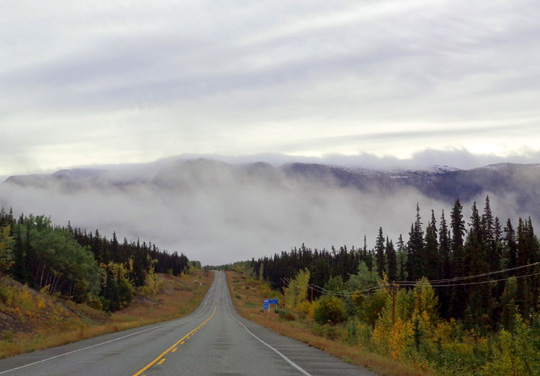
Rain and fog are common along the routes through
the mountain ranges in Canada in the spring,
summer, or fall. I took this photo somewhere
between Whitehorse and Watson Lake, YT. (9-8-12)
However, we have heard from other RVers and residents that the major roads
through northern Canada and Alaska are usually passable even in
the winter. Friends from Whitehorse, YT that we met in the desert last
spring drove their RV home in mid-April and reported that they had no trouble with
snow and ice on their route. You've got to be extra careful during the
off-season to top off your fuel tank when you have the opportunity or
carry a large secondary tank so you don't get stranded in a remote area.
If you like snow, it may be possible to drive to Alaska even in the more
wintry months. An alternative would be to fly to Anchorage or Fairbanks
and rent a vehicle to get where you want to go.
Good luck with that! It might be fun if you're staying in a motel but I
sure wouldn't try to camp in an RV up there during the winter.
LAST ONES OUT, TURN OFF THE LIGHTS
Despite anecdotal evidence that major roads are usually passable even
in the winter, Jim and I wanted to make sure we got out of Alaska and
northern Canada before the roads became slick with ice or snow.
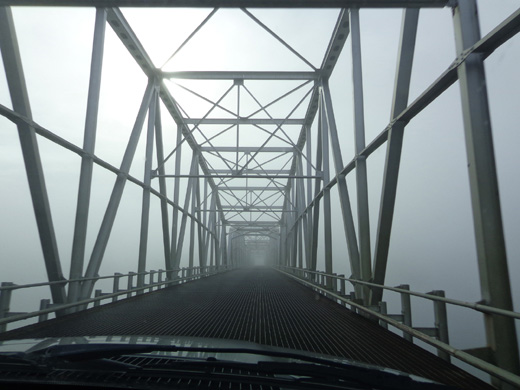
Here's another picture of the heavy fog we
encountered between Whitehorse and Watson Lake
on the way back. It's a good thing we saw scenic Nisutlin Bay on the way to Alaska because
we couldn't even see the water this day! This is
the longest bridge on the whole Alaska Hwy. (9-8-12)
We weren't sure when the roads would become slick but we checked weather forecasts every day in
early September for several towns along the two routes we were
considering -- Fairbanks and Tok, AK, Whitehorse and Watson Lake, YT, Fort St. John and Prince
George, BC, and several places in Alberta (Banff, Jasper, Grande Prairie, Calgary).
We decided to leave Fairbanks on September 6 because temperatures
were already dipping close to freezing, even earlier than normal. We can stay
warm when it's cold but with an RV you have to be careful about water
pipes freezing and cracking. We decided it was time to get out of Dodge.
Even that early, however, in some places we felt like we were the last ones
out and should be turning off all the lights!
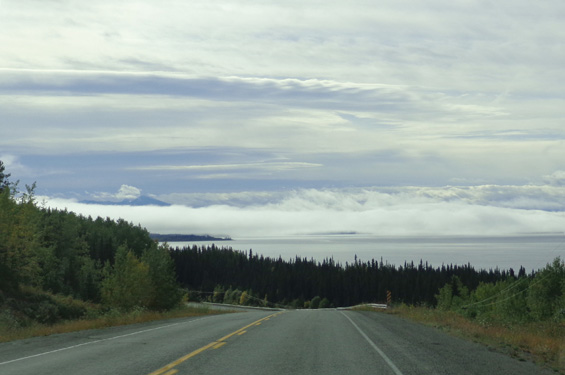
We could see Teslin Lake in the Yukon as we
approached it in September
but the distant mountains were shrouded in fog.
Note the lack of traffic. (9-8-12)
Traffic was very light from Fairbanks to Whitehorse and beyond,
outside of towns and cities. There were only two cars ahead of us
at the border crossing into Canada on September 6. There were so many in June that it took over an hour to get through
the U.S. border from Canada on our way to Alaska. When we were
driving around Kluane Lake in southwestern Yukon in September we sometimes went for
ten minutes or more without seeing another vehicle in either direction.
If you've never experienced that kind of isolation on a paved highway
in broad daylight, you should try it sometime!
In early September we saw "Closed for the Season" signs on several visitor centers,
campgrounds, restaurants, gas stations, and other businesses through
Alaska, the Yukon, and northern British Columbia:
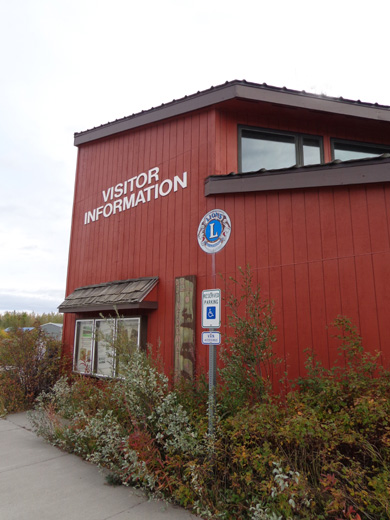
"Closed for the season" said the
sign on the door to the visitor center in
Delta Jct., AK but we could
wander around and see some exhibits outside. (9-6-12)
Whoa! Where did everybody go???
They apparently migrated south for the winter already!
Fortunately, we didn't have any trouble finding diesel fuel
or campgrounds on our way back through Canada. Just about all the
services were available in the larger towns along the Alaska Hwy. and as
we proceeded farther south more and more businesses were still open.
We just had to be sure we filled our fuel tank any time we had a long
stretch of wilderness. We also carried spare diesel in a five-gallon
tank until we got to more populated areas in Alberta.
We could see "terminal dust" on low mountains in Alaska and the Yukon
at the end of the first week of September (earlier than that at Denali). That's the
first light dusting of snow that falls each autumn:
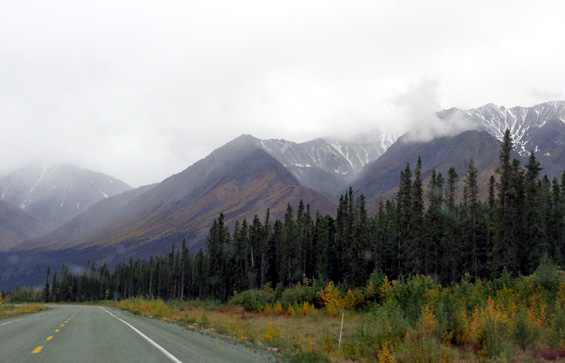
Low clouds and terminal dust on
the Kluane Range in the Yukon (9-7-12)
Snow is pretty when we can see it but don't have to deal with it on
the road. Luckily, we didn't get into any snow or ice at the
elevations we were driving (up to 4,250 feet), nor did we
encounter any overnight temperatures below freezing before we reached
warm weather in southern Alberta.
We might have had some problems if we'd taken the Icefield Parkway
through Jasper and Banff national parks, however. We chose the Alaska
Hwy. on the return trip because the weather was warmer, drier, and less
windy on that route than the Cassiar and Yellowhead Highways on the days
when we'd be going through that area.
THE SEASONS ARE MOVING TARGETS
Even if you have a lot of flexibility re: when you drive
to/from Alaska, timing a trip up there is like aiming at a moving target. There are too
many variables to get it exactly "right."
Just go when you can and be prepared for any kind of weather.
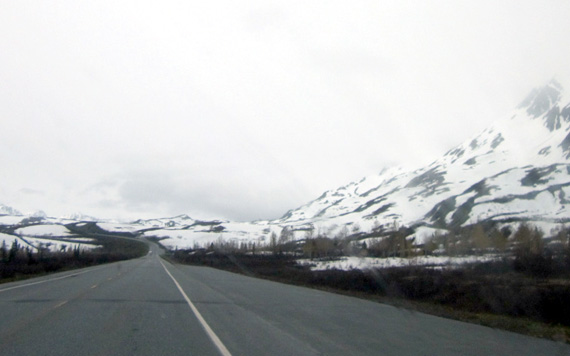
Winter snow remained at road level
near Thompson Pass
north of Valdez in mid-June but the road was clear.
(6-14-12)
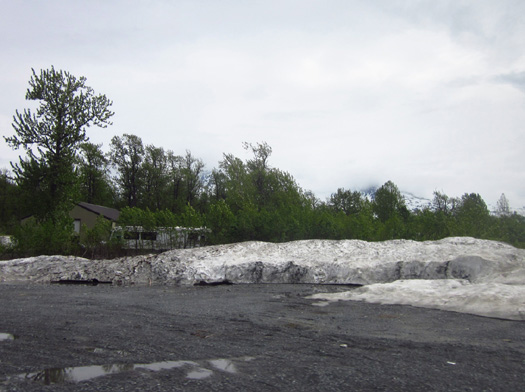
There were still big piles of melting snow in
vacant lots in Valdez in mid-June. (6-14-12)
Some winters are longer and have record amounts of snow, like 2011-2.
We waited to begin our trip across the border until we knew the
temperatures were consistently above freezing at night and the roads
were clear.
This year that wasn't likely until early June. After a mild winter we
could have safely gone earlier than that.
Autumn is a moving target, too -- and very short. Wintry
weather is close behind.
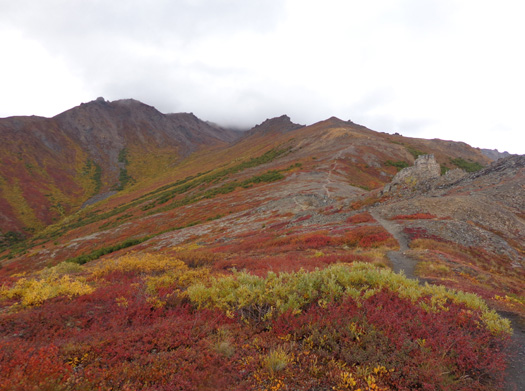
Vivid fall colors brighten the
tundra on Healy Ridge in Denali NP (9-2-12)
Once you start seeing fall color at any elevation or latitude along
paved roads in Alaska it's time to start thinking about leaving if you want to avoid
snow and ice through the higher mountains in the Yukon and British Columbia on
your way back to the Lower 48.
Continued on the next page: in defense of spontaneity +
more about this year's weather woes in Alaska
Happy trails,
Sue
"Runtrails & Company" - Sue Norwood, Jim O'Neil,
and Cody the ultra Lab
Previous
Next
© 2012 Sue Norwood and Jim O'Neil
